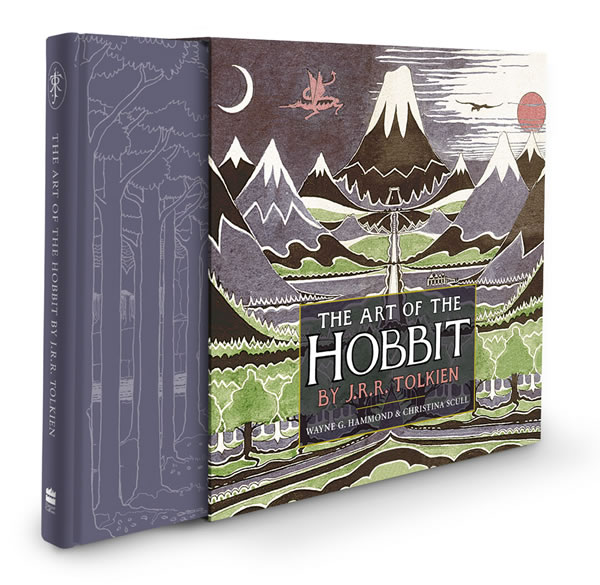Interview with Wayne Hammond and Christina Scull about The Art of the Hobbit (02.08.11 by Damien Bador) -
Comments
In April I received an e-mail by Damien Bador, of Tolkiendil, who requested to translate and publish the following interview I did with Wayne Hammond and Christina Scull in L’Arc & le Heaume, the yearly journal of Tolkiendil. Since he was in contact with Wayne Hammond and Christina Scull to ask their permission as well, we found it a good time to add some extra questions - mostly about their upcoming book The Art of the Hobbit.
I'm glad to publish their answers here, just in time before the publication of their new fantastic book, The Art of The Hobbit.
DB: Your next project, titled The Art of The Hobbit by J.R.R. Tolkien, will feature many unpublished drawings made by J.R.R. Tolkien to illustrate The Hobbit or produced by him for other purposes and reused to serve as inspiration for his illustrations. Were these illustrations unavailable when you published J.R.R. Tolkien: Artist and Illustrator in 1995, or was there simply not enough space to publish all you would have liked to?
WH & CS: We were, in fact, limited in the number of pictures we could reproduce in Artist and Illustrator — to only about 200 — and only half of those could be in colour. The other Hobbit illustrations were known to us at the time.
DB: J.R.R. Tolkien’s illustrations for The Hobbit provide vivid images of Bilbo’s journey. To what extent do you think that Tolkien’s practice as an illustrator and map-drawer has influenced him in writing his novel?
WH & CS: Tolkien had mental pictures of his characters and scenery while he was writing, as all writers do. His skill at painting and drawing allowed him sometimes to put his visions into pictorial as well as verbal form, and sometimes he used pictures — particularly maps — to help him work out points of story. But he was primarily a writer rather than an artist. Some of his Hobbit illustrations, however, influenced the writing of The Lord of the Rings, as he had established certain features of Hobbiton and Rivendell (for instance) in pictures which were not described in the text of The Hobbit, but which then entered into its sequel.
DB: It seems J.R.R. Tolkien drew much fewer pictures for The Lord of the Rings than for The Hobbit. Was it due to the different character of the book or to the constraints in completing a work much more ambitious and elaborate than The Hobbit?
WH & CS: Tolkien wrote The Hobbit in the first instance for his children (and himself), and was free to include illustrations in its private manuscript. When the work was wanted for publication, it was meant from the start that the book should include maps, but Tolkien was used to it having pictures, and convinced Allen & Unwin to add illustrations. In fact it was not unusual for a book aimed at young readers to have pictures, and the publisher probably realized that Tolkien’s art added value. The Lord of the Rings, however, was not for children, and its text was so long and costly to print, in three volumes, that a full range of illustrations was out of the question. Also, although Tolkien had privately drawn a few pictures for The Lord of the Rings — in part in the process of working out details — by that time he preferred to have his books illustrated by Pauline Baynes.
DB: Both The J.R.R. Tolkien Companion and Guide and The Lord of the Rings: A Reader’s Companion are considered reference books in the English-speaking world of Tolkien studies. Is there any plan to translate them in French? What about The Art of the Hobbit?
WH & CS: We would be very pleased to have the Companion and Guide and the Reader’s Companion translated into French. No one has translated them yet into any language! Of course this would have to be formally licensed through HarperCollins. We have not yet heard if The Art of The Hobbit by J.R.R. Tolkien has been licensed for translations.
DB: Once The Art of The Hobbit is completed, are there any other tolkien-related projects you are planning to work on?
WH & CS: We have one or two ideas which we hope to develop with HarperCollins and the Tolkien Estate, but are not yet free to talk about them. Wayne has done some preliminary work on a second edition of his J.R.R. Tolkien: A Descriptive Bibliography. Otherwise, we have been working on a bibliography of the work of Pauline Baynes.
Authors: Wayne Hammond, Christina Scull
Publisher: HarperCollins
Publication Date: December, 2011
Type: hardcover, 128 pages
ISBN-10: 0-00-744081-2
ISBN-13: 978-0-00-744081-8
Spread the news about this J.R.R. Tolkien article:
